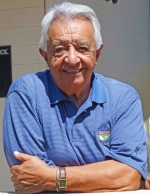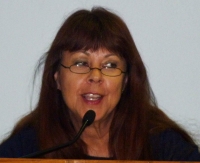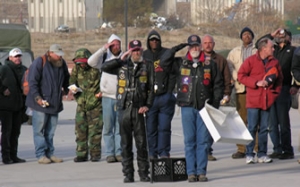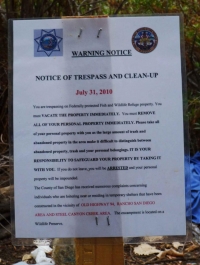By Jeremy Los
“This issue has received band-aid approaches to fix it when it needs a tourniquet.” – La Mesa Mayor Art Madrid
“We look at them as a resource… they are the eyes and ears of the community… they certainly know when something is going on.” – El Cajon Mayor Mark Lewis, on the homeless in his town
"I do not feel there needs to be a regional center for the homeless in East County." -- Lemon Grove Mayor Mary Sessom
"I am not in the homeless business." - Santee Mayor Randy Voepel

April 26, 2011 – Four East County mayors shared their reactions on a new study on the many homeless in our region. Their views differed dramatically on how to address the homeless problem. In addition, three of the four mayors questioned the study findings and voiced doubts on the numbers of homeless people listed in their cities.
According to the 2011 Point-In-Time Count by the Regional Task Force on the Homeless, East County is now home to 8.9% of San Diego County’s homeless population, with El Cajon staking claim to the highest number of homeless people. However, the majority of El Cajon's homeless are in shelters--while in other East County communities, the homeless are living on the streets, in cars, or camped along riverbeds.
Countywide, the number of homeless grew 5.9%. In East County, expanding the number of locations counted and changes to methodology make comparisons more difficult. Spring Valley’s level actually dropped from 284 to 99, but that likely reflects a homeless sweep conducted by the Sheriff along the Sweetwater Riverbed. Other areas, such as La Mesa and Santee, saw large increases in homeless numbers. El Cajon has 342 homeless, the survey found.
 According to the survey, one out of every 11 homeless people resides in the East County, roughly 802 people out of 9,020 countywide. Unincorporated areas, most of which are in East County - amounted for 285 unsheltered homeless. Spring Valley and Lakeside were counted having 99 and 98 unsheltered homeless respectively, while Alpine had 12 and Jamul 21. Ramona was counted having four homeless, but according to Litwak, that area only had three volunteers making it possible that not every homeless person was accounted for.
According to the survey, one out of every 11 homeless people resides in the East County, roughly 802 people out of 9,020 countywide. Unincorporated areas, most of which are in East County - amounted for 285 unsheltered homeless. Spring Valley and Lakeside were counted having 99 and 98 unsheltered homeless respectively, while Alpine had 12 and Jamul 21. Ramona was counted having four homeless, but according to Litwak, that area only had three volunteers making it possible that not every homeless person was accounted for.
Other East County neighborhoods also saw high homeless numbers reported. Lemon Grove was reported having 94 unsheltered homeless, while La Mesa was counted having 55, all of which are unsheltered. Santee reportedly has 58. But three out of four mayors have raised questions about the findings of the count.
Below are details on the homeless levels in Santee, El Cajon and La Mesa, along with comments from each local mayor.
Santee
 Santee, a city that has grown exponentially over the past decade, was reported having 58 unsheltered homeless in 2011, up from 15 in 2010, a number that Mayor Randy Voepel vehemently denies.
Santee, a city that has grown exponentially over the past decade, was reported having 58 unsheltered homeless in 2011, up from 15 in 2010, a number that Mayor Randy Voepel vehemently denies.
“We have never had more than 12-15 ever. The Sheriff’s Department monitors the homeless closely and currently put the number (Santee homeless) at 13, mostly in the river bottom” said Mayor Voepel in an email to ECM. “The Regional Task Force is either incompetent or liars, to inflate the Santee homeless count over 300%.”
Mayor Voepel has since repealed the claim that the Regional Task Force is inflating its numbers, but insists that the count is not entirely accurate.
“I am convinced that they are not ‘cheating’ but relying on volunteers for the counts, volunteers (especially activists) may not reflect the real count for many reasons that are aboveboard,” states Voepel.
The Santee City Council plan to discuss the findings at their next meeting scheduled to take place Wednesday evening at 7 p.m.
Executive Director of the Regional Task Force on the Homeless for San Diego County Peter Callstrom stands by the results of the count, which tallies the homeless using three different categories: an individual, a vehicle or personal structure/tent.
“We revisited the count that was reported back to us by the volunteers,” said Callstrom. “We have reviewed all the data and we don’t find any error in the count.” He added that there would be no benefit to inflate the numbers, noting, “Housing and Urban Development does not allocate money to this region based on the count… there is zero financial incentive.”
Callstrom points out the Sheriff department’s lack of categorizing individuals living in vehicles as homeless could account for the considerable difference in counts. Volunteers in the study are trained to indentify homeless vehicles based on the amount of personal belongs in the vehicle as well as spotting someone asleep.
In Santee, volunteers were able to count 20 individuals plus 19 tent and vehicles. In order to estimate how many people were living in the tents and vehicles – since the count was done early in the morning (people sleeping in vehicles or tents might not be visual) - volunteers used a methodology that was adopted locally back in 2005 per Housing and Urban Development’s mandate. The methodology calls for volunteers to use a multiplier of two to estimate the amount of people living in tents and vehicles.
Callstrom admits that the methodology used only provides an estimation of how many homeless there are, but points out that in past studies the methodology has provided a pretty accurate assessment of homeless populations.
Callstrom states that the count raises a broader question, given past sweeps to clear out the homeless in East County, such as from Spring Valley’s Sweetwater Riverbed.
“What do we do now that we know people are in certain locations? Do we toss them out, or do we get them into housing and services?” he asked. “I’ve heard that Santee is the one city in the county that hasn’t signed onto PTECH, Plan to End Chronic Homelessness, through United Way.” (Editor’s note: This program is being rebranded as Home Again. “I was told that Santee was the only holdout because Mayor Voepel did not think there were homeless in Santee; hopefully we can bring him around.”
Santee does spend money on the homeless, though it is minimal according to Mayor Voepel, “The amount of spending Santee does on the homeless is very little because of the small amount (of homeless) the city has… the city does spend $5,000 for social services to fund the Crisis House.”
“I am not in the homeless business,” proclaims Mayor Voepel, who insists that homelessness is an issue for the County and the State to address.
El Cajon
 About 342 homeless people take shelter in El Cajon, far more than any other East County neighborhood, with the majority, 226, being unsheltered and on the streets.
About 342 homeless people take shelter in El Cajon, far more than any other East County neighborhood, with the majority, 226, being unsheltered and on the streets.
El Cajon has one of the lowest per-capita incomes in San Diego County. But the high rate of homelessness in El Cajon does not put a black eye on the city, according to Mayor Mark Lewis, wo finds a silver lining to the issue.
“We are not worried about the homeless,” said Mayor Lewis, when discussing the impact of the homeless on the city’s image. “We look at them as a resource… they are the eyes and ears of the community… they certainly know when something is going on.”
Mayor Lewis insists that a lot of El Cajon’s homeless are only temporary, and says that many are people who have hit a rough patch due to the economic downturn.
Numbers confirm Lewis’ point. The study indicated that unemployment was the main cause for homelessness throughout the county, cited by 37% of homeless people as the reason behind their current situation. Eviction/foreclosure was a distant second with 10%.
“There is a growing homeless problem,” says Sean Oliver, Director of the Development Department at the East County Transitional Living Center “and El Cajon is the beacon of homelessness in the East County.”
La Mesa
 Of all the East County neighborhoods La Mesa had one of the fewest number of homeless residents, though according Litwak the 55 homeless counted doubled the 26 counted in 2010 with only 70% of the census tract being counted. A count that Mayor Madrid thinks might be a bit stretched if only 70% of the census tract was accounted for.
Of all the East County neighborhoods La Mesa had one of the fewest number of homeless residents, though according Litwak the 55 homeless counted doubled the 26 counted in 2010 with only 70% of the census tract being counted. A count that Mayor Madrid thinks might be a bit stretched if only 70% of the census tract was accounted for.
“I would like to know the methodology,” said Madrid, “how reliable is the figure? I would like to know what kept them from counting the other 30 percent; it becomes suspect that they only counted 70 percent. “
Nonetheless, Mayor Art Madrid views the homeless situation as a societal issue.
“The homeless issue in La Mesa is no different than the homeless issue throughout America,” said Madrid. “This issue has received Band-aid approaches to fix it when it needs a tourniquet.”
According to Madrid, the city is in talks with local church leaders about the societal issues facing La Mesa. “Churches try to do something for societal needs. Churches help anyone, it is not denomination oriented, it is about helping people of society.” says Madrid.
The amount of homeless veterans is an issue weighing heavily on the mayor. According to the Regional Task Force 17.86% of the county’s homeless are veterans.
“We should be embarrassed, as a society, by the number of homeless that are veterans,” said Madrid.
Lemon Grove
 All of Lemon Grove’s 94 homeless individuals are unsheltered, according to the report.
All of Lemon Grove’s 94 homeless individuals are unsheltered, according to the report.
Mayor Mary Sesson told East County Magazine that although her city does not count its homeless, “that number seems high just based on what I’ve observed and what I’ve heard reported by both our Sheriff’s deputies and our citizens.”
She said her city’s problems are unique. “As the smallest of the East County cities, we do not have any assistance programs. Some of our churches and social service agencies participate in various collaborative which provide a myriad of social services including assistance to the homeless.”
Those services do not provide shelter for homeless people, however.
No County or Community-run shelter in East County
 Neither the County nor any City in East County operates a homeless shelter, leaving homeless people in East County who seek help with two options: traveling to downtown San Diego for services, or accepting assistance from church-run programs.
Neither the County nor any City in East County operates a homeless shelter, leaving homeless people in East County who seek help with two options: traveling to downtown San Diego for services, or accepting assistance from church-run programs.
That’s fine with Mayor Sessom. “I do not feel there needs to be a regional center for the homeless in East County,” she stated. “While we may be in an era of shrinking budgets for both public and private institutions, there are services available suited to each city’s situation.”
Some homeless experts disagree.
“Personally, I think affordable housing is need in order to help our homeless neighbors regardless of where they are in the county,” said Jennifer Litwak, Manager of Projects and Development at the Regional Task Force on the Homeless.
The homeless in El Cajon, according to Mayor Lewis, have many options available to them if they wish to seek out help. Lewis names Crisis House and the East County Transitional Living Center as valuable resources for the homeless community in El Cajon.
East County Transitional Living Center is a faith-based organization ran by CEO and Pastor Harold Brown. The ECTLC is a new incarnation of Set Free Ministries, which was founded by Phil Aguilar; according to CityBeat, Aguilar has been compared to cult leaders David Koresh and Jim Jones. Brown has said his organization’s affiliation with Set Free was a loose one; he realized it was time to make a split because Set Free’s religion-focused model narrowed the organization’s reach.
The East County Transitional Living Center receives some funding from the City of El Cajon for the non-secular aspects of its program, providing short-term shelter for people on the streets with its voucher program. The organization’s annual operating budget is $1.1 million, and it provides housing for 300 people.
In order to receive long-term assistance including job training, ho homeless individuals would have to enroll in a “Disciples” program that is faith-based and receives no government funding.
Lewis sees no problem with the city providing funding to a religious organization, pointing out that the organization understands that some people don’t want religion. That view is affirmed by Oliver.
“We definitely provide programs that are secular in nature, as well as our faith based programs,” said Oliver. “We are not going to turn anyone away seeking help.”
 But some suggest that the County should take responsibility for the homeless in East County. Currently, homeless seeking County help must make their way to downtown San Diego—a long distance from places like Lakeside and Ramona, where public transportation is limited. A call to Supervisor Dianne Jacob’s office was not returned by press deadline.
But some suggest that the County should take responsibility for the homeless in East County. Currently, homeless seeking County help must make their way to downtown San Diego—a long distance from places like Lakeside and Ramona, where public transportation is limited. A call to Supervisor Dianne Jacob’s office was not returned by press deadline.
“I think a regional homeless center would be a step in the right direction,” said Litwak. “The interesting this is about East County is that it is geographically huge, so having one is going to be helpful but it won’t solve the homeless problem.”
The Regional Task Force on the Homeless and Executive Director Callstrom seek to solve or at least limit the growing homeless problem in East County and San Diego County.
“We all want to end this, but if there’s one thing I want to emphasize," said Callstrom, “Let’s talk about how we end this [homelessness] versus debating how this count has occurred.”









Comments
On Santee's homeless, there's a good discussion of it here:
http://santee.patch.com/articles/santee-mayor-questions-santee-homeless-...
Some readers of Santee Patch are weighing in on where they've seen homeless, and at least one homeless person has posted a comment. Several say they've personally observed more homeless in Santee than they mayor believes are there, and one suggested that all the homeless people in Santee should show up at this evening's meeting!
East County Homelessness Count 2011
Thank you for covering this issue. We appreciate the opportunity to explain how we go about the Point-In-Time Count (PITC) for our County.
According to the methodology that was established in 2005 (when the Point-In-Time Count project began in San Diego County), it was decided to account for two persons when a vehicle or homeless encampment (tent, etc.) was observed - rather than wake people up. This was based upon experience throughout the country in order to adequately estimate when conducting these counts. In some cases, this can overestimate, in others, it's not enough. As many as four or five individuals are known to be found in vehicles, tents, or other structures. On average, we've found it to be an appropriate and fair estimate.
Regarding Mayor Madrid's comment on the 70% coverage in La Mesa, this is due to the fact that the PITC is completely volunteer-driven. With such a large county, 100% coverage is incredibly difficult. This year, we had 550 intrepid volunteers (up from less than 400 volunteers in 2010) who walked, drove, and scoured their assigned territories. Some volunteers found no homeless, others found many – all depending upon where they were assigned.
If we do not have enough volunteers, we still maximize their efforts by making sure that they count in areas that are known to likely contain homeless individuals (e.g., versus gated communities, and other unlikely areas, etc). Going forward, we need more local volunteers and hope that more city leaders, community members, and concerned citizens join our efforts next year – you know your city best – help us to ensure the very best count.
During our count on January 28, 2011 (between 4am and 8am - the time frame when the count always occurs), 20 individuals were counted and 19 vehicles/structures were identified in Santee. By applying our methodology, this equals the 58 that we reported. The 'visible' homeless count of 20 individuals is close to what Mayor Voepel asserts. However, with 19 vehicles and/or structures identified, these individuals are harder to identify, may be on the move, etc.
Yes, the count requires judgment when determining who and how many folks are homeless. It is a challenging process, but one that we approach with great care and thanks to an excellent volunteer turnout this year, we had the most comprehensive count to date.
Why do we do this count, and what is the outcome/benefit of this effort?
1. The PITC is a U.S. Department of Housing and Urban Development (HUD) mandate. The data is critical to our continuum of service provision. HUD uses data from the PITC (and other data sources) to complete the Annual Homeless Assessment Report - AHAR. The AHAR is submitted to Congress and helps determine needs and resource allocation.
http://www.hudhre.info/documents/5thHomelessAssessmentReport.pdf
2. Data from this count is necessary for our cities and County to apply for federal funds - about $15 Million in federal funds for services are allocated to our region annually.
3. The PITC data is an important part of the process to inform HUD. Funds come to the region based upon many factors, most importantly - quality of services, not a higher number of a count in a PITC. We look forward to a lower count – this would be great to report to everyone.
4. Data will enable us to guide and potentially assist with difficult political choices/options.
5. Knowledge + Understanding = Action
6. To end homelessness. It is hard work to end homelessness. It requires individual attention, services, affordable housing, employment, and much more. We know that doing nothing, or hoping they go away, costs our cities and county more than investing in solving this problem.
I understand Mayor Voepel's concern. He wants an accurate count - so do we. We will be working with city officials to clarify the count as well as to explore solutions to the crisis of homelessness in our region. I also applaud Mayor Voepel and the Santee City Council for their support of the Santee Food Bank and other services that serve folks in need. The city of Santee is full of people with big hearts.
There are other things we can all do together to help prevent, alleviate, and ultimately end homelessness. Working together is the answer. When we do, we find affordable solutions, overcome differences, and actually make progress on this seemingly intractable problem. Check out this story - a collaborative and ongoing effort in downtown San Diego - one in which the RTFH is proud to be an active partner. Solving homelessness is possible...
http://www.npr.org/2011/03/08/134035384/campaign-aims-to-open-doors-for-...
In the end, we ALL share the same goal: to end homelessness. Potholes or homelessness - these are all issues that affect us individually and collectively. When we work together, we can get past how many may be accounted for on a single day and instead focus on solving the problem that exists throughout our County.
We welcome more community members to help us with the count in 2012 (Save the date - Friday, January 27).
Best Regards,
Peter Callstrom, Executive Director
Regional Task Force on the Homeless (RTFH)
www.RTFHSD.org
www.RTFHSD.org/pitcresults.html
Nice to see the changes at
Nice to see the changes at the East County Transitional Living Center. Used to be way too ridgid with faith based idealogy when Set Free ran it, although I'm sure they have and continue to help many.. Some people who desperatly need help cannot deal with religous attitude and refuse to go to places that have such a regime. That said, Kudos to every person, church, business, and other, including the City of El Cajon (via the taxpayer) and Crisis House - who help those that have fallen on hard times.There are many reasons for being homeless and precious few answers for long term resolution.
Veterans homless? Very sad indeed. The federal government needs to step up with a better game plan, after all, these men and women went into military service to help this country for their own reasons and deserve better!
How were the 'homeless' who live in backyards, choosing to remain under the radar - counted? I would guess that the 'actual' count may be higher than anyone knows.